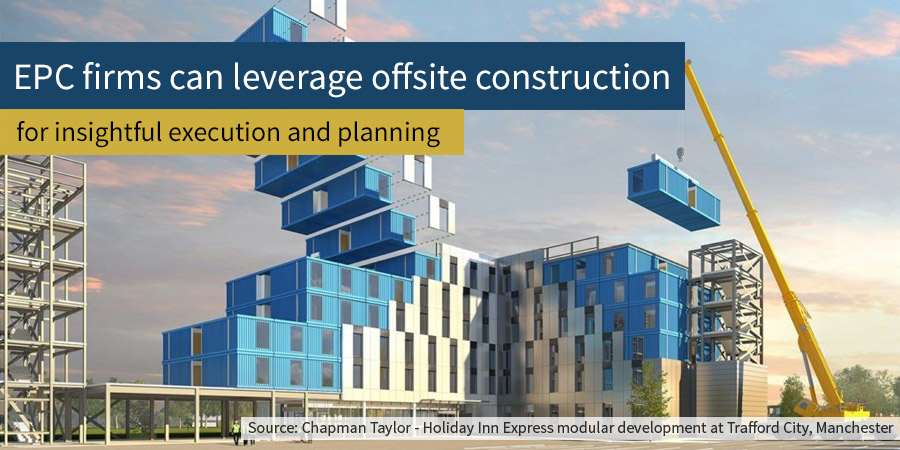EPC Firms can leverage Offsite Construction for insightful Execution and Planning
Insightful Execution and Planning for EPC firms with the advent of Offsite Construction

Insightful Execution & Planning By EPC Firms
The construction planning for a simple commercial facility isn’t as difficult as industrial plant design planning and construction or even a healthcare facility. The challenge with the latter set of building types is that they tend to be more complex, owing to extra care and safety for including large industrial ovens or easy navigation through the facility for patients.
And to EPC firms this means imposing heavy controls over the sub-contractors related to scheduling, code of accounts, definitive cost estimate, and budget planning, and coordinating all these activities for the coherent construction phase. When offsite construction is practiced, the usual order that any EPC firm would adopt follow a set and predefined order as enlisted:
- Contract terms
- Labor availability
- Site logistics
- Technical complexity
- Major equipment and material sources
- Extent of field fabrication
Challenges pertaining to offsite construction
In a paper released by Foster Wheeler about modularization, it says, “Important for every modular project is the maximum module size that can be fabricated, shipped, and transported.” And when planning isn’t executed as documented, the offsite construction logistics becomes unmanageable.
Secondly, offsite construction also sets the limits of the workforce on site hook-up and therefore it will impose a major hurdle to allocate the resources immediately. Also, this doesn’t leave any scope of supplying reinforcement onsite, even by the EPC firm itself, when deadlines are to be met.
Embracing offsite construction ‘smartly’
However, in spite of these inherent challenges, there are umpteen advantages, since a bulk of the fabrication is performed at the remote location, enabling achievement of higher quality. Especially for industrial plant, when fabrication of steel structures and every unit is done remotely, it automatically eliminates the infights for interdisciplinary simultaneous works onsite.
But if all the resources are allocated and actions are planned with the maximum flexibility right at the outset of any construction project it becomes easier to accommodate changes or manage anything out of usual. An accurate scheduling and planning of activities before the construction begins by leveraging 4D BIM model and a Timeliner sequencing video will essentially eliminate a major lot of these challenges.
The biggest issue with unavoidable circumstances is it delays the progress of construction work which will enforce the EPC contractor to push the deadlines behind. Even if the firm wants to meet the deadline, since the construction approach is modular, planning logistics will not permit. But when sequencing video is generated using Timeliner or an excel spreadsheet, all the possible resources and elements of the building are allocated with utmost care and flexible planning done right from the start.
Offsite and stick-built – the perfect mix
On the other hand, EPC firms have also embraced a combination of modular and traditional best practice of ‘stick-built’ approach which means that large projects like industrial plant construction will allow modular building at several stages. Let’s say a part of steel structures and columns are fabricated remotely; maybe several units of the warehouses too are included. This leaves only the assembly and installation to be done on site.
The construction industry needs a shift, from stick-built to modular; probably a blend of both in the least case, but the shift is necessary. While EPC firms need a shift in their ideology of embracing offsite in spite of the challenges it poses strongly with BIM.












